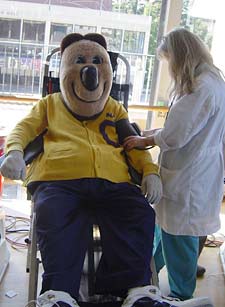Berkeleyan
With creative thinking from all, at Berkeley there will be blood
Federal rules prohibit gay men from donating blood, so campus health officials consider alternative approaches
![]()
| 11 September 2008
 Last spring, San Jose State University President Don Kassing took a controversial stand when he halted his campus’s blood drives to protest the Food and Drug Administration’s 1983 policy prohibiting men who have had sex with other men from giving blood. The FDA ban on accepting blood from gay men violates the university’s anti-discrimination policy, Kassing said.
Last spring, San Jose State University President Don Kassing took a controversial stand when he halted his campus’s blood drives to protest the Food and Drug Administration’s 1983 policy prohibiting men who have had sex with other men from giving blood. The FDA ban on accepting blood from gay men violates the university’s anti-discrimination policy, Kassing said.
The FDA ban, intended to stem the spread of HIV-AIDS, has angered members of the gay community who say that tests that can detect HIV-positive donations and maintain the safety of the blood supply now exist.
One Berkeley student took a decidedly different approach to draw attention to the FDA policy. During his junior and senior years, Jeff Manassero seized on a way to make a statement without adversely affecting the blood supply. He organized sexually active gay Cal students to ask eligible donors to give blood in their name.
| Next Monday, Sept. 15, the first Berkeley blood drive of the fall semester will take place from noon to 6 p.m. in Alumni House. Campus blood drives are held monthly (usually on Mondays); the dates are always posted on the Berkeley events calendar. To learn how to get involved, visit the blood-drive webpage. To make an appointment to donate, visit the Red Cross website and use the sponsor code “UCB.” Walk-ins are also welcome. |
Manassero’s impetus stemmed from his own negative experience, when he was denied the opportunity to donate in high school after affirming that he’d had sex with other men. The longstanding FDA policy makes that exclusion permanent. Being barred from contributing blood was a traumatic experience, he says: “There’s a stigma attached to not giving blood. If you don’t give blood, people ask why not?”
“A lot of gay men and many people in the general population don’t know the [FDA] policy exists,” notes Manassero. The donate-by-proxy effort he spearheaded was labor-intensive, though Manassero doesn’t see his approach as the only way to draw attention to the situation. “It’s important to find other ways to make inclusive blood drives,” he says.
Terence Kissack and John Paul, members of Lavender Cal, Berkeley’s social network for LBGT faculty and staff, saw similar desires reflected in e-mails posted on that group’s listserv. “There were some concerns about the policies that govern who can and can’t give blood, how those policies are articulated, and what it means to people emotionally,” says Kissack.
Kissack, who works in University Relations’ prospect-development unit, and Paul, resident director in Unit 3, took those concerns to the campus work group that oversees Berkeley’s blood drives. “We started talking about how the communication materials are phrased and framed, and what that means to various audiences,” says Kissack. “We felt that the positive contributions that the blood drives make are real and need to be sustained, supported, and expanded. The question is not pulling the blood drive down but building on it.”
Even for those who prefer not to donate blood or who aren’t eligible to do so — and that list includes people who have lived in Europe for more than five years since 1980 or those who procured a tattoo in a state where tattoo parlors are unregulated — there are other opportunities to help with the campus’s blood drives.
What sponsorship entails
Campus departments, units, or groups can sponsor a drive, which involves working with the campus sponsors, the American Red Cross and UC San Francisco Medical Center, to recruit donors, promote the event, and volunteer on collection day. Individuals can encourage friends to donate using suggested phrasings posted on University Health Services’ blood-drive website, volunteer at a drive, and post flyers about upcoming blood drives in their office.
Such efforts are critical, since Bay Area blood banks rely heavily on donations from universities and colleges, says Sara O’Brien, communications manager for the American Red Cross, Northern California Blood Services Region.
“There’s a very big shortfall,” she says. “Among the blood centers in Northern California — Blood Centers of the Pacific, Stanford Blood Center, American Red Cross — we all bring blood in from other parts of the state and the country to cover the needs of the Bay Area. Twenty to 40 percent of the blood on our shelves has come from other parts of the state or the U.S.”
As for the FDA policy, O’Brien says, “We have to follow the rules and regulations to make sure we have a safe blood supply.” She adds: “Everybody — the American Red Cross, America’s Blood Centers, the American Association of Blood Banks — is encouraging the FDA to look at and change the policy.”

